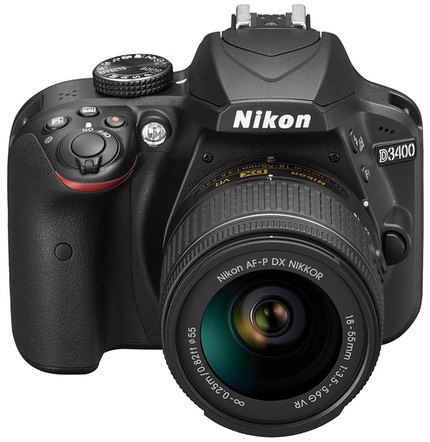
Nikon today announced the replacement model for their low end DX DSLR, the D3400. In conjunction with the new camera Nikon re-introduced the 18-55mm AF-P DX lenses plus announced two new 70-300mm f/4.5-6.3 DX AF-P lenses. Both AF-P DX lenses are available in VR and non-VR versions.
The D3400 doesn’t deviate much from the D3300 it replaces. In terms of body design and basic electronics, it’s the same. The “new” bits are the inclusion of Bluetooth to support SnapBridge, a much-needed-but-probably-still-wrong rework of the Guide mode, some additional special effects, and the ability to grab location data from a connected smartphone. All the basic elements—sensor, EXPEED4, fps, shutter, flash, video, autofocus system, metering system, etc.—remain exactly the same as the previous model.
Somewhere in the process, the D3400 body dropped 15g of weight, but otherwise it’s identical in size and shape to the D3300. In other words, Nikon didn’t push the bar very far, if at all.
The good news, of course, is that the D3300 was a very capable camera: great sensor in a marginal body. This didn’t change with the D3400. If anything, Nikon has tweaked a bit of JPEG quality out of the D3400 that you couldn’t get with the D3300, but I doubt most people would notice.
It seems curious that the D3400 got delayed so long. It was originally intended to be announced early this year, but has sat in the production queue for a number of months awaiting something (probably finished Bluetooth software). More to the point, Nikon seems to have little idea of how to improve the low-end camera. Yes, adding SnapBridge—assuming they get it to work as advertised—is useful. But in reality, what’s the real marketing message now?
One takeaway that a lot of long-time Nikon owners seem to be having is that Nikon has no real insights in how to make their low-end DSLR more relevant to the modern world, let alone how to make it a far better product than it is. Given that we’re seeing the camera six months later than expected and so little has been changed, one really has to wonder just exactly how much effort Nikon is putting into the low-end DSLR designs now.
In essence, both Canon and Nikon are continuing their established crop sensor consumer DSLR positions with no real innovation now. By that I mean that consumer DSLRs are competing pretty much solely on price and the fact that DSLRs are what people have been buying (more than mirrorless). But the fact of the matter is that DSLRs don’t sell as much as they did before the peak in 2012. So is it the chicken or the egg that’s the problem? Is lower sales levels making the camera makers spend less effort in improving the new models? Or is less effort in improving the new models making for lower sales?
The answer is, of course, both. This is classic monopolistic behavior in mature product categories (though we have a duopoly here). It’s all about cutting costs and improving profits, not about increasing sales. And the first cost that gets cut is R&D.
Along with the D3400, Nikon re-announced the 18-55mm AF-P kit lenses (VR and non-VR versions), plus a new companion 70-300mm AF-P lens, also available in both VR and non-VR versions. These AF-P lenses work only on recent DX bodies, and use a stepper motor instead of Nikon’s usual wave motor. The claim is that the stepper motor is quieter than the AF-S motors that have been in use, and better for video. But I’ll bet the real reason is that the stepper motors are simpler and cheaper.
Support this site by purchasing from the following advertiser:





